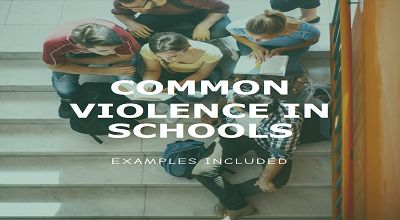Violence in Schools
Violence in Schools can take various forms, and it’s essential to address and prevent these issues to ensure a safe and productive learning environment. Here are some common types of violence that can occur in schools, along with examples:
Physical Violence:
- Fights: Physical altercations between students can escalate into violence. For example, two students get into a fistfight in the hallway.
- Bullying: Repeated physical aggression, such as hitting or pushing, can occur between students. For instance, a group of students cornered and physically assaulted another student on the school bus.
Verbal Violence:
- Verbal Harassment: Name-calling, insults, and derogatory comments directed at students or teachers. For instance, students taunt a classmate because of their appearance or ethnicity.
- Threats: Students making threats of violence against others, whether in person or through digital communication like social media or text messages.
Psychological/Emotional Violence:
- Cyberbullying: Harassment, humiliation, or intimidation through online platforms. This can include spreading rumors about a classmate or posting hurtful messages on social media.
- Exclusion: Socially isolating a student or group of students, leaving them feeling excluded and emotionally hurt.
Sexual Violence:
- Sexual Harassment: Unwanted sexual advances, comments, or gestures. For example, a student makes inappropriate sexual remarks to another student.
- Sexual Assault: Non-consensual sexual acts, which can include unwanted touching or more serious offenses.
Weapon-Related Violence:
- Carrying Weapons: Students bring weapons like knives or guns to school, which pose a severe threat to the safety of others.
Substance Abuse-Related Violence:
- Drug-Related Violence: Altercations or conflicts arising from the use or distribution of drugs or alcohol on school premises.
Gang-Related Violence:
- Gang Activity: Violence associated with gangs, including fights between rival gang members, recruitment efforts, or intimidation.
Teacher-to-Student Violence:
- Abuse of Authority: Instances where teachers or school staff physically or verbally abuse students.
Student-to-Teacher Violence:
- Assault on Teachers: Physical or verbal attacks by students against teachers. For example, a student physically assaulting a teacher during a classroom disruption.
Hate Crimes and Bias-Motivated Violence:
- Bias Attacks: Violence or harassment targeting individuals based on their race, religion, ethnicity, gender, or other protected characteristics.
Vandalism and Property Damage:
- Property Destruction: Deliberate damage to school property, such as graffiti, arson, or destruction of equipment.
Social Violence:
- Rivalry or Feuds: Long-standing rivalries between groups of students that can escalate into conflicts or violence.
Final Words
To address these issues, schools often implement anti-violence programs, counseling services, conflict resolution strategies, and disciplinary measures. Additionally, fostering a culture of respect, empathy, and open communication can help prevent violence and create a safer learning environment.
